Adventure of the Dancing Men Analysis
Sherlock Holmes' The Adventure of the Dancing Men demonstrates some unique literary qualities Doyle embedded into his tale.

- Series of Inferences
- Plot Structure
- Descriptions of Sherlock
- Hilton Cubitt
- The Solution and Pre-Introduction Pronouncements
- Did Sherlock Fail?
- Compare Elsie to Other Women in Sherlock Tales
- Literary Techniques in Dancing Men
- Background Info & Fun Facts
- An Emotional Contrast: Tone
Our Analysis of The Dancing Men
This analysis comes from Sherlock Holmes: The Unit Study.Information and activities related specifically to The Dancing Men are on this page below.
Pre Reading Activity
Before reading the story, readers were asked to look for three things:- What is your reaction to the title “Dancing Men?”
- What is your initial reaction to this story when you see the dancing men?
- How does your reaction change at the end of the story?
![]()
Sherlock's Series of Inferences
A Pre-Introduction Pronouncement
Our story opens with Sherlock showing off his deductive prowess with a series of inferences which startle even Watson - who should be used to it by now."It is not really difficult to construct a series of inferences, each dependent upon its predecessor and each simple in itself. If, after doing so, one simply knocks out all the central inferences and presents one’s audience with the starting-point and the conclusion, one may produce a startling, though possibly a meretricious effect."The short stories in the Sherlock canon often begin with a broad statement by Holmes which is supported by the plot that emerges. This is called the Pre-Introduction Pronouncement.
The quote above comes from the Pre-Introduction phase of the story and initially referred to Holmes' conclusion about Watson's intent to not invest in South African securities.
What is the literary trick here? Sherlock solved this case by using one of his series of inferences - just as he described in the opening.
See the section below on Holmes Announces the Solution to The Dancing Men.
![]()
Plot Structure
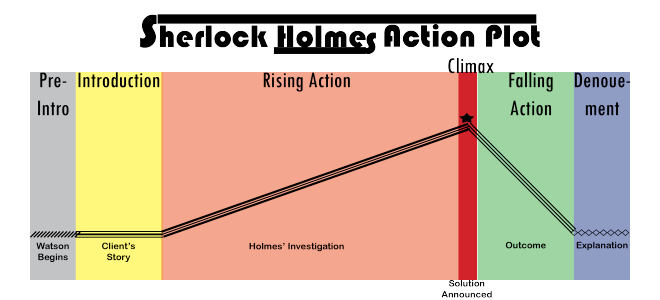
- Pre-Introduction: Sherlock impresses Watson with his "series of inferences" that conclude Watson doesn't plan on investing his money.
- Introduction: Mr. Hilton Cubitt narrates his tale of the effect the dancing men is having on his beloved and trusted wife.
- Rising Action: A ten part series of ascending action begins after Cubitt's narration. Much of the drama in the first four parts rises and falls with Hilton's communications.
- Holmes asks a few questions and Cubitt leaves to go home.
- Two weeks later Cubitt returns with copies of three more messages and the report that the man had come to their farm at night and his wife stopped Cubitt from confronting him.
- Sherlock works to decipher the four messages. He sends a telegram to Chicago.
- Two days later he gets letter from Cubitt with a long message that alarms him. They plan to go to Norfolk but the next train doesn't leave until the next morning.
- They arrive in Norfolk and find that Hilton is dead.
- Holmes arrives at the manor and listens to the servants’ account.
- Holmes investigates the crime scene.
- Holmes sends a letter to Elrige farm and instructs the inspector to call for additional police help.
- While waiting, Holmes shares how he deciphered the dancing men.
- Climax: The arrest of Abe Slaney marks the story's climax.
- Falling Action: Abe tells his side of the story and missing details are filled in.
- Denouement: The epilogue states Elsie recovered and remained a widow at the manor.
Unique Features of This Action Plot
While this story largely follows the typical Doyle pattern listed above, it does have some unique features of its own:- The Pre-Introduction has more action than usually seen in the opening paragraphs.
- The denouement consists of an "official epilogue."
- The tone of the story starts light-hearted and ends very dark.
- Our great detective failed (which will be discussed more below.)
- The explanation of the case is given during the wait (the last point of the Rising Action section bullet-listed above.)
Usually Doyle reserves the "official explanation" for the Falling Action phase of his story - not the Rising Action phase. But here he makes good use of his character's time while waiting for the suspect to arrive, even though the reader and the characters don't know the identity of the murderer.)
![]()
Descriptions of Sherlock
This particular story has some great descriptions of the master detective. Check out these four sentences: all of which could be model sentences for inspiring writers:Holmes had been seated for some hours in silence with his long, thin back curved over a chemical vessel in which he was brewing a particularly malodorous product.
Imagine you had never read a Sherlock story before. What information does the reader obtain immediately in the first sentence? And for those acquainted with Holmes, consider how this sentence affects their mental picture of the scene in which Watson begins this particular narrative.
As he deciphered the cryptic message:
Sometimes he was making progress and whistled and sang at his work; sometimes he was puzzled, and would sit for long spells with a furrowed brow and a vacant eye. Finally he sprang up from his chair with a cry of satisfaction, and walked up and down the room rubbing his hands together.
Riding to the manor
Without a word Holmes hurried to a carriage and during the long seven miles’ drive he never opened his mouth. Seldom had I seen him so despondent. He had been uneasy during all our journey from town, and I had observed that he had turned over the morning papers with anxious attention, but now this sudden realization of his worst fears left him in a blank melancholy. He leaned back in his seat, lost in gloomy speculation.
At the manor
Holmes sat in a great, old-fashioned chair, his inexorable eyes gleaming out of his haggard face. I could read in them a set purpose to devote his life to this quest until the client whom he had failed to save should at last be avenged. (This is quite a contrast to Holmes' flippancy at the end of many cases.)
![]()
About Hilton Cubitt
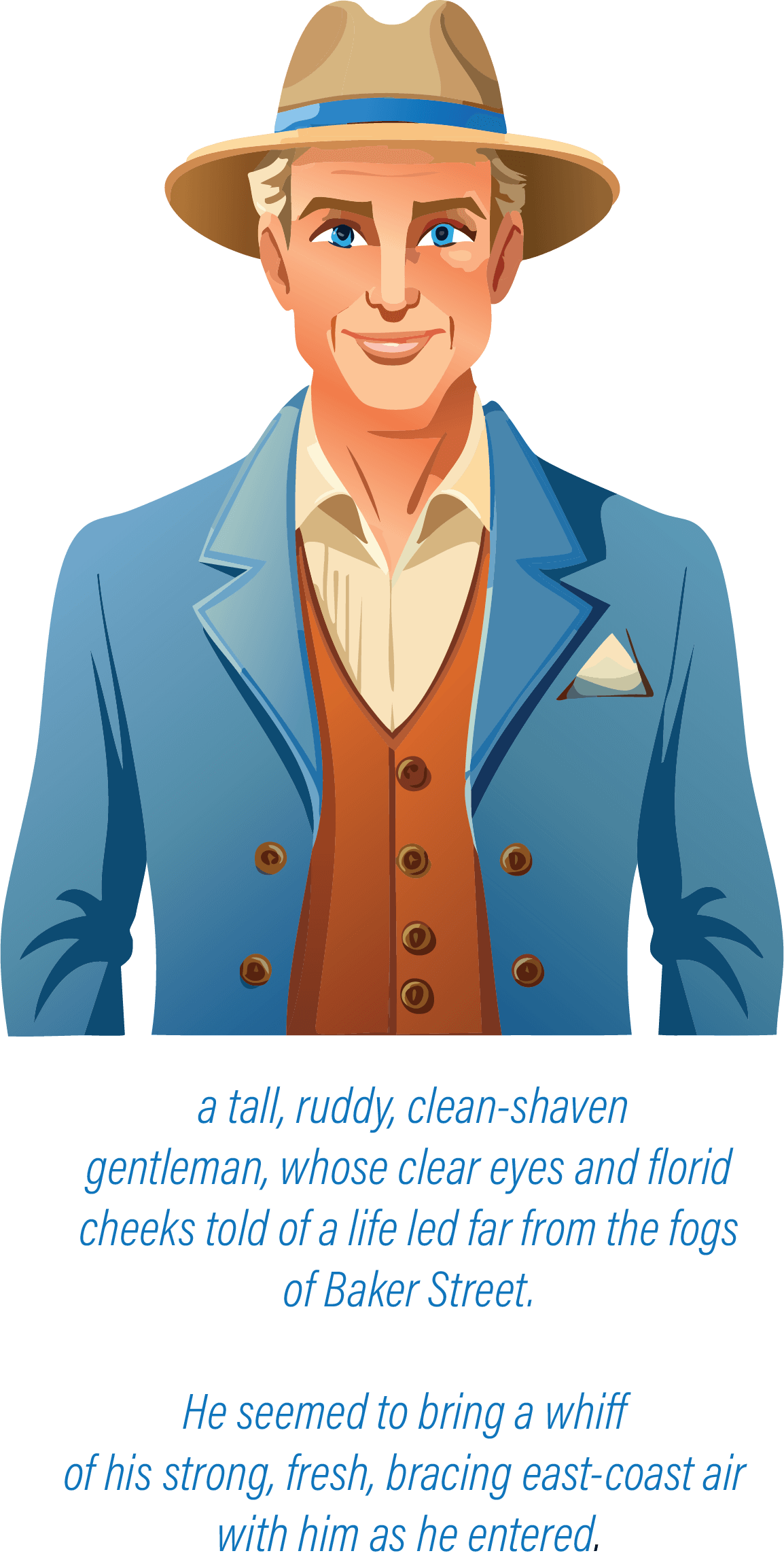
Physical Description
...there entered a tall, ruddy, clean-shaven gentleman, whose clear eyes and florid cheeks told of a life led far from the fogs of Baker Street. He seemed to bring a whiff of his strong, fresh, bracing east-coast air with him as he entered.
Character Description
He was a fine creature, this man of the old English soil -- simple, straight, and gentle, with his great, earnest blue eyes and broad, comely face
![]()
Holmes Announces the Solution
The Servants' Report
Holmes narrows in on a few specific details of the servants' report:- One retort was louder than the other.
- The passageway filled with smoke.
- A candle on the table was lit.
Holme's Investigation
Holmes' physical inspection uncovers these additional clues overlooked by the inspector:- The bullet hole in the window sash
- The cartridge in the garden
- Footprints in the garden
Series of Inferences
Holmes uses the facts highlighted above to create a series on inferences in which he concludes a third person was in the room. This astounds the inspector, but upon hearing the explanation, the inspector agrees with his conclusion.Where have we seen that before? In the Pre-Introduction with Watson and the South African investments, Sherlock worked through a series of inferences. Here he does that same thing, to the amazement of his audience in the room AND his readers.
Pre-Introduction Pronouncements
If you go back through all the Sherlock Holmes short stories, you will see that Doyle embeds these Pre-Introduction Prounouncements in many of the stories. Most of the time the story starts with one of two types:- Watson wrote an opening paragraph that explains why he chose to report a specific case.
- Watson wrote about a conversation with Holmes prior to the arrival of the client.
What One Man Can Invent
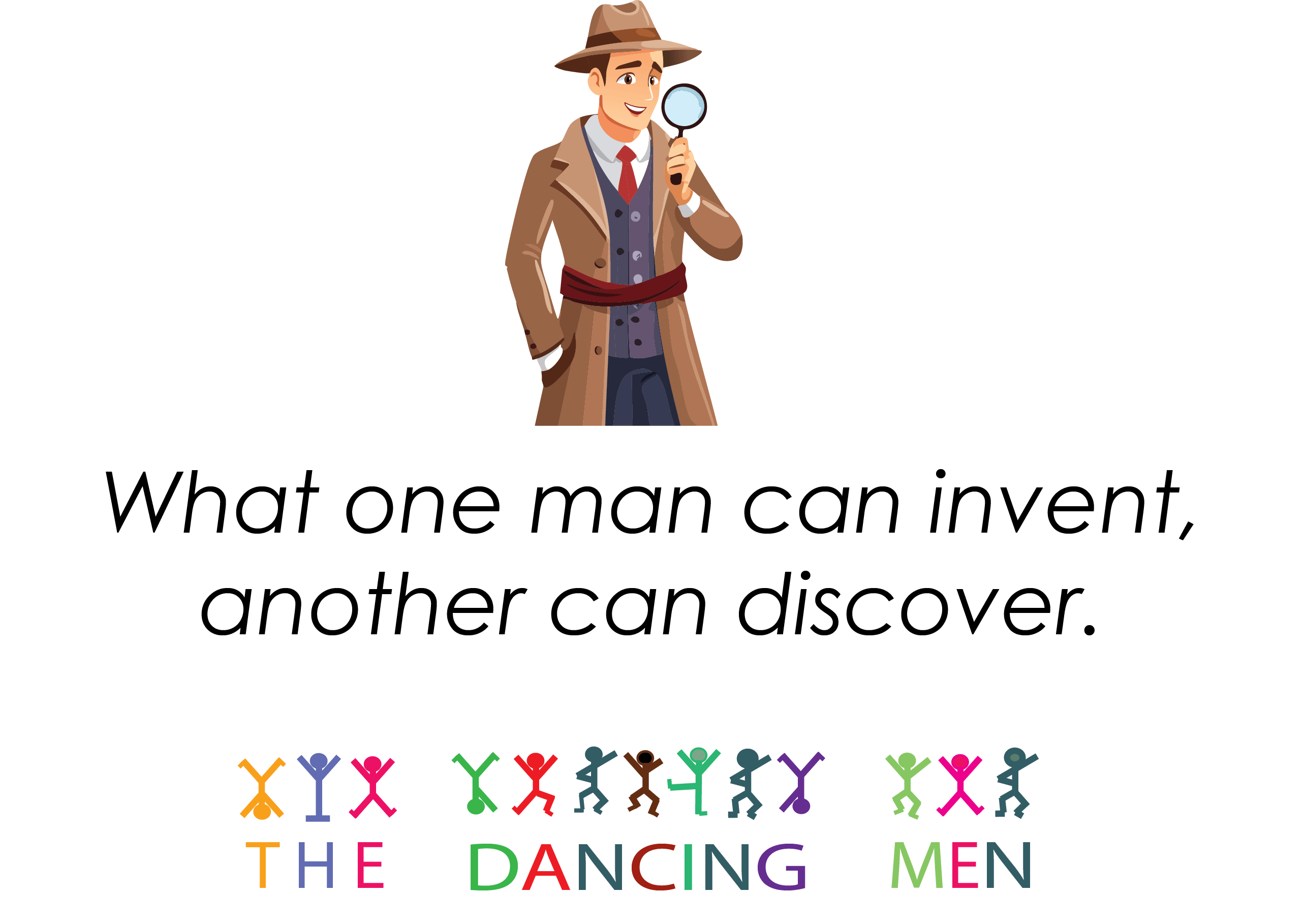
What one man can invent another can discover.To some extent, we can see this quote covers much of what Sherlock spent his days and years doing - uncovering what others invented.
In another way, we can say it is what we are doing: discovering the hidden details of Doyle's writing that makes Sherlock a world-famous character.
![]()
Did Sherlock Holmes Fail?
The stated mission was to find what the drawings represented which he did do. So on the one hand, he succeeded. But, obviously, of more importance he did not stop the crime that he, and he alone, foresaw.Let’s compare that to his failure in A Scandal in Bohemia. In that case he failed at his stated mission of obtaining the photo, but succeeded at the more important mission of protecting the king’s reputation. In The Dancing Men, he succeeds at his stated mission of finding the cause of the figures, but fails in the more important mission of protecting his client's life.
There are only two stories in the Sherlock canon where his client loses his life. (We won't disclose the other so we don't spoil outcomes for new readers.)
Preventing This Outcome
Obviously as a fictitious story, Doyle could cause any outcome he wanted. But what if it was a true story? (Of course, we the readers have a literary obligation to pretend it is as we read.)Could Cubitt's death have been prevented? What circumstances might have changed the outcome?
- When they missed the last train for the day, they might have found another way to get to Norfolk.
- Sherlock could have telegraphed Cubitt or the Norfolk police his suspicions that a Chicago gangster was involved.
The Irony of Honor in this Story
The concept of Cubitt’s honor was highlighted several times.Elsie Cubitt did not tell her husband the truth because she was trying to protect his family’s honor. Her choice ended up costing his life AND his family's reputation.
- By Cubitt when he first met them: I want to say first of all that, though I’m not a rich man, my people have been at Riding Thorpe for a matter of five centuries, and there is no better known family in the County of Norfolk.
- Hilton’s reason for not pushing his wife to reveal her problem: A promise is a promise.
- His wife’s reason for not telling him the truth: She has spoken about my old famiy, and our reputation in the county, and our pride in our unsullied honor.
- The man at the station: Dear, dear, one of the oldest families in the county of Norfolk, and one of the most honored.
A Discussion On Ethics
To some exent, one could say Sherlock AND Hilton AND Elsie all contributed to the bad outcome.- Is failure to prevent a crime the same thing as guilt for causing a crime?
- Is anyone responsible for Slaney's actions besides Slaney?
- Did Sherlock, Hilton, and/or Elsie have responsibility to prevent the crime?
Doyle's Decision
Of course, as literary analysts, we recognize that it was Doyle himself as a fiction writer that caused Hilton's death. This leads us to another question?- Is it realistic that any detective will have perfect outcomes 100% of the time?
- Is it better for Doyle to cause Sherlock to fail sometimes, or better to make him perfect?
![]()
Elsie & Women in the Sherlock Series
Critics frequently assess Sherlock (and Doyle) for the role of women in these Victorian-era stories. Let’s make a comparison of Elsie and two other women you have met.Compare Elsie and Other Women

- Give Irene Adler in Scandal in Bohemia a “5” as a independent woman.
- Give Helen Stoner in The Adventure of the Speckled Band a “1” as an independent woman.
- How would you rate Elsie?
Culture and Literary Criticism
When evaluating characters - fictitious or non-fictitious - from another era or culture, it is beneficial to concientiously view them from three different angles:- Their own culture
- Our own culture
- From the wider angle of all cultures
Another Look at Elsie
A few paragraphs ago we asked you to rate Elsie on a scale of 1 to 5 for the quality of “independence.” That activity was largely done as a comparison. It is not an accurate way of assessing all of a person’s strengths and weaknesses.Here are some of the behaviors we have learned about Elsie. Mark each as a strength or weakness.
- She left the gang when she understood their lifestyle. (strength)
- Independently moved to another country to get away from them (strength)
- Tried to protect her husband’s reputation (strength)
- Avoided help when she was in a situation she could not handle (weakness)
- Loyal to her husband (strength)
- Her servants liked her. (strength)
- Attempted suicide rather than seek justice against a murderer (weakness)
- By attempting suicide, she was more likely to sully her husband’s name. (weakness)
- She rebuilt her life and tried to do good for others once she recovered. (strength)
![]()
Literary Techniques Used by Doyle
Pre-Introduction Pronouncement
The "series of inferences" described above is the example of Pre-Introduction Pronouncement made in this story. You will find that Doyle applied a similar technique in many of this short stories. (It's subtle and will be missed by those not looking for it.) But Watson or Holmes often make an opening declaration of something that the case proves.Verbal Kickback
Mrs. Hudson makes a very brief appearance. Movie producers usually give her a more prominent role than Doyle did. Examine this dialogue:Then we shall breakfast early and take the very first (train) in the morning. Our presence is most urgently needed. Ah! here is our expected cablegram! One moment, Mrs. Hudson, there may be an answer. No, that is quite as I expected. This message makes it even more essential that we should not lose an hour in letting Hilton Cubitt know how matters stand...Readers can examine this passage closely and notice several things. First Mrs. Hudson is kept as a minor character with a minimal role to play. Even though she appears and reappears throughout the stories, she doesn't get much in terms of speaking parts.
Second, Doyle uses a verbal kickback in Holmes' dialogue to make the reader aware of action in the room that the author did not narrate. It doesn't say Mrs. Hudson arrived in the room, yet by interupting his own narration Holmes let's you know that she came, gave him a telegram, he read it, and has drawn a conclusion about it.
Foreshadowing
As the rising action continues Watson darkens the tone with these words:...as I come to the dark conclusion of a story which had seemed to me to be only childish and bizarre, I experience once again the dismay and horror with which I was filled (then.) Would that I had some brighter ending to communicate to my readers, but these are chronicles of fact...
Keeping Watson in the Dark
We have noted previously in Sherlock: The Unit Study that keeping Watson in the dark is a literary technique that keeps the reader in suspense until the final conclusion is to be announced. (Something your average detective is not going to do in reality. They want to catch the criminal with everyone’s help.)We have granted Doyle literary license to keep us and Watson in the dark. In this story alone, Sherlock/Doyle address the issue of Sherlock’s silence on Watson:
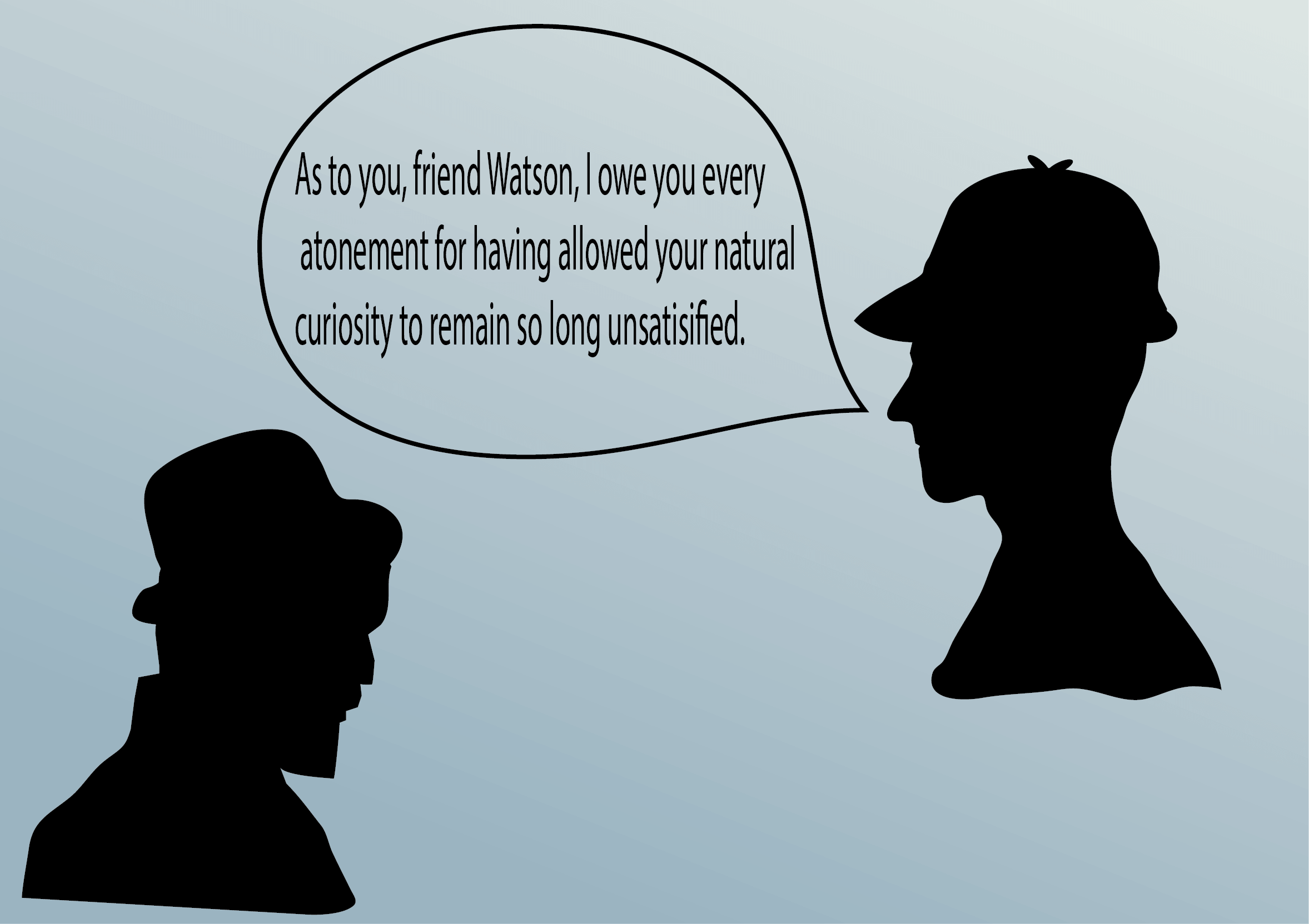
Back in their London apartment Watson wrote: I confess that I was filled with curiosity but I was aware that Holmes liked to make his disclosures at his own time and in his own way.Watson undoubtedly forgave Holmes for keeping him in the dark so long. Of course, we do too. Otherwise we wouldn't have an exciting story!
While waiting for the arrival of the criminal Holmes begins to unravel the puzzle by saying: As to you, friend Watson, I owe you every atonement for having allowed your natural curiosity to remain so long unsatisified.
![]()
Background Info &
Fun Facts for Dancing Men
Watson's Checkbook
Are you wondering why Holmes stated that he had Watson’s checkbook locked in his own drawer and Watson had not asked for the key? I mean, would you like it if you had a roommate who would lock up YOUR checkbook? Readers find out in a few other stories that Watson had developed a gambling habit when he returned from the war so Holmes would keep his checkbook locked up and only let him have it for valid expenses.What Is A Squire
Mr. Cubitt, it turns out, is a squire. For those of us on the western side of the pond, squires are not common to behold so a little background info might be helpful.Squire comes from a French word “esquire” meaning “shield bearer.” In the Middle Ages the squire was the trusted shield-bearer of a knight, always at hand to do his master’s bidding. Squires were often young knights-in-training who learned by observing all the knight did.
Once gun powder obliterated the life of knights-in-shining-armour, squires became the owners of large rural estates. And this is where we find our trusted Mr. Cubitt.
And speaking of squires, you might be interested to know that Sherlock himself is the son of a squire, apparently deceased since there is no other information about him in all sixty stories. Sherlock - it is said in the first story - wanted to make his own way in the world.
Riding Thorpe Manor of Norfolk
The Riding Thorpe Manor is fictitious. Norfolk is a county on the east coast of England. It is about 100 miles north west of London.We learn in the story that Hilton's family has been at the manor for over five centuries.
![]()
Emotional Contrast - Tone
As our pre-reading activity, unit study participants were asked to identify their reactions to:- To the title “Dancing Men”
- To the problem of the figures of the dancing men
- To the final outcome of the story
- The title sounds light-hearted, maybe funny.
- The comical drawings are childish (that was Watson’s reaction.)
- The final outcome was dark and sinister.
We start with a brisk, light tone and end with a seriously dark tone. Even so, our serious detective whose somber objective was to revenge his client, still manages to end with a flippant final word:
"And so my dear Watson, we have ended by turning the dancing men to good when they have so often been the agents of evil, and I think that I have fulfilled my promise of giving you something unusual for your notebook. Three-forty is our train, and I fancy we should be back in Baker Street for dinner."
Buy Sherlock Holmes: The Unit Study
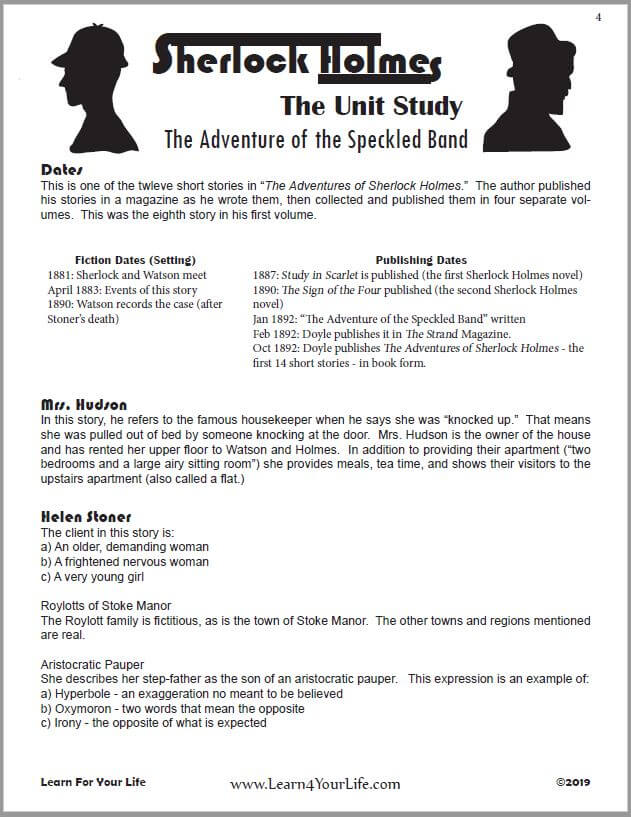
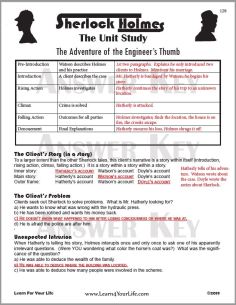
Student Guide AND Teacher's Answer Key Included
$2.99 Download - 183 pages
Eight of the most popular tales demonstrate how to investigate a detective story.
![]()
Sherlock Holmes Pages
A catalog of our pages on Sherlock Holmes.


About Our Site
Hands-On Learning































